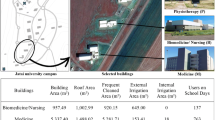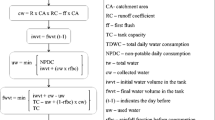Abstract
Recently, rainwater harvesting systems have received increased attention due to their capability for adapting to water scarcity and climate change. However, a key obstacle to the implementation of rainwater harvesting systems is that they are often not financially feasible given difficulty in determining optimal system size. A key premise of previous studies was that all rainwater harvesting systems are constructed in a single construction event even though it is possible to construct a system in multiple stages. This assumption limits managerial flexibility in the construction of rainwater harvesting systems, which is particularly valuable in scenarios where it is difficult to forecast future rainfall patterns. Therefore, we propose a multi-stage system expansion strategy for the implementation of rainwater harvesting systems using decommissioned septic tanks under scenarios of uncertainty in rainfall from a real option perspective as a means to improve the financial feasibility of implementing rainwater harvesting systems. We tested this strategy by evaluating a proposed rainwater harvesting system for a midsize apartment complex in Jeonju, South Korea. The multi-stage expansion strategy generated an option value of 9,896 USD. This study will help to improve the financial feasibility of rainwater harvesting systems by adding the value of managerial flexibility through a sequential expansion of RWH systems as new information becomes available.




Similar content being viewed by others
Notes
All costs were estimated by (Jeonju Water Development Board 2011) and were expressed in nominal US dollars unless otherwise stated. Values were converted from Korean Won using a 1 to 1,100 U.S. Dollar to Korean Won exchange rate. A 5.43 % of annual increase in cost of construction was applied to those estimates.
- $$ {\displaystyle \sum_{n=1}^{27}\frac{5,521.3\times 1.88\times {\left(1+0.0509\right)}^n}{{\left(1+0.0514\right)}^n}} $$
- $$ 1.26\times {\left(1+0.00509\right)}^{2021-2013} $$
- $$ \frac{278,420}{54,060+104,190}-1 $$
5,170-76,130 + 2,340
References
Bank of Korea (2013) Economic Statistics system. Seoul, Republic of Korea (http://ecos.bok.or.kr/)
Chung E-S, Park K, Lee KS (2011) The Relative Impacts of Climate Change and Urbanization on the Hydrological Response of a Korean Urban Watershed. Hydrol Process 25(4):544–560
Copeland T, Antikarov V (2003) Real Options–a practitioner‶s Guide. TEXERE, New York
Cox J, Ross SA, Rubinstein M (1979) Option Pricing: A Simplified Approach. J Financ Econ 7(3):229–263
Department of Health (2011) Decommissioning or Reuse of On-site Wastewater systems. Factsheet No. 500. Northern Territory, Australia. (http://www.health.nt.gov.au/environmental_health/wastewater_management/index.aspx).
Dore MHI (2005) Climate Change and Changes in Global Rainfall Patterns: What do we Know? Environ Int 31(8):1167–1181
Herrmann T, Schmida U (1999) Rainwater Utilisation in Germany: Efficiency, Dimensioning, Hydraulic and Environmental Aspects. Urban Water 1(4):307–316
Hewitson BC, Crane RG (2006) Consensus Between GCM Climate Change Projections With Empirical Downscaling: Precipitation Downscaling Over South Africa. Int J Climatol 26(10):1315–1337
Hughes L (2003) Climate Change and Australia: Trends, Projections and Impacts. Aust Ecol 28(4):423–443
Imteaz MA, Shanableh A, Rahman A, Ahsan A (2011) Optimisation of Rainwater Tank Design from Large Roofs: A Case Study in Melbourne. Australia. Resour Conserv Recycl 55(11):1022–1029
Jenkins MW, Lund JR (2000) Integrating Yield and Shortage Management Under Multiple Uncertainties. J Water Resour Plan Manag 126(5):288–297
Jenkins D, Pearson F, Moore E, Sun JK, Valentine R (1978) Feasibility of Rainwater Collection Systems in California. Californian Water Resources Centre, CA
Jeonju Water Development Board (2011) A Plan Rainwater Management in Jeonju City. Republic of Korea, Jeonju (in Korean)
Kim M, Kwak D, Han M, Yang J (2009) Recycling of a Discarded Septic Tank as a Rainwater Management System and its Economic Feasibility Analysis. J Korean Soc of Water and Wastewater 23(5):647–654 (in Korean with English abstract)
Lee KS, Chung ES, Kim YO (2008) Integrated watershed management for mitigating streamflow depletion in an urbanized watershed in Korea. Physics and Chemistry of the Earth, Parts A/B/C 33(5):82–394
Liaw CH, Tsai YL (2004) Optimum Storage Volume of Rooftop Rainwater Harvesting Systems for Domestic use. J Am Water Resour Assoc 40(4):901–12
Michailidis A, Mattas K (2007) Using Real Options Theory to Irrigation dam Investment Analysis: An Application of Binomial Option Pricing Model. Water Resour Manag 21(10):1717–1733
Michailidis A, Mattas K, Tzouramani I, Karamouzis D (2009) A Socioeconomic Valuation of an Irrigation System Project Based on Real Option Analysis Approach. Water Resour Manag 23(10):1989–2001
Mukheibir P (2008) Water Resources Management Strategies for Adaptation to Climate-Induced Impacts in South Africa. Water Resour Manag 22(12):59–76
Mun JS, Han MY (2012) Design and Operational Parameters of a Rooftop Rainwater Harvesting System: Definition, Sensitivity and Verification. J Environ Manag 93(1):147–153
Oreskes N (2005) The Scientific Consensus on Climate Change. Science 306(5702):1686
Panigrahi B, Panda SN, Agrawal A (2005) Water Balance Simulation and Economic Analysis for Optimal Size of on-Farm Reservoir. Water Resour Manag 19(3):233–250
Park T, Kim B, Kim H (2012) Impact of Deterioration and Negotiation on Sewer System O&M Contracts from the Real Option Perspective. Water Resour Manag 26(10):2973–2989
Park T, Kim C, Kim H (2014) Park T, Kim B, Kim H (2014) Valuation of Drainage Infrastructure Improvement Under Climate Change Using Real Options. Water Resour Manag 28(2):445–457
Rozos E, Makropoulos C, Butler D (2010) Design Robustness of Local Water Recycling Schemes. J Water Resour Plan Manag 136(5):531–538
Seo Y, Choi N-J, Park D (2012) Effect of Connecting Rain Barrels on the Storage Size Reduction. Hydrol Process 26(23):3538–3551
Srivastava RC (2001) Methodology for Design of Water Harvesting System for High Rainfall Areas. Agric Water Manag 47(1):37–53
Su M-D, Lin C-H, Chang L-F, Kang J-L, Lin M-C (2009) A Probabilistic Approach to Rainwater Harvesting Systems Design and Evaluation. Resour Conserv Recycl 53(7):393–399
Suttinon P, Nasu S (2010) Real Options for Increasing Value in Industrial Water Infrastructure. Water Resour Manag 24(12):2881–2892
Texas Water Development Board (2005) The Texas Manual on Rainwater Harvesting, 3rd edn. Austin, TX
Wade SD, Rance J, Reynard N (2013) The UK Climate Change Risk Assessment 2012: Assessing the Impacts on Water Resources to Inform Policy Makers. Water Resour Manag 27(4):1085–1109
Wei H, Li JL, Liang TG (2005) Study on the Estimation of Precipitation Resources for Rainwater Harvesting Agriculture in Semi-Arid Land of China. Agric Water Manag 71(1):33–45
Yates MV (1985) Septic Tank Density and Ground-Water Contamination. Groundwater 23(5):586–591
Yates MV, Yates SR (1989) Septic Tank Setback Distances: A way to Minimize Virus Contamination of Drinking Water. Groundwater 27(2):202–208
Youn S-G, Chung E-S, Kang WG, Sung JH (2012) Probabilistic Estimation of the Storage Capacity of a Rainwater Harvesting System Considering Climate Change. Resour Conserv Recycl 65(7):136–144
Zhang XY, Cai HJ (2003) The Development of the Model to Simulate and Optimize the Rainwater-Harvesting System for Irrigation. J Exp Bot 54:45–46
Author information
Authors and Affiliations
Corresponding author
Rights and permissions
About this article
Cite this article
Kim, B., Anderson, K., Lee, S. et al. A Real Option Perspective to Value the Multi-Stage Construction of Rainwater Harvesting Systems Reusing Septic Tank. Water Resour Manage 28, 2279–2291 (2014). https://doi.org/10.1007/s11269-014-0613-3
Received:
Accepted:
Published:
Issue Date:
DOI: https://doi.org/10.1007/s11269-014-0613-3




